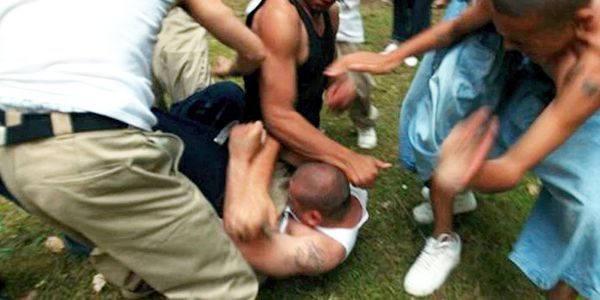When I hear in the media about sudden violence against civilians, I often find out that the victim, more often than not, made several mistakes in dealing with the situation — and these mistakes often proved fatal. Is this the victim’s fault? Yes, it is. In most cases they were overconfident, they didn’t take the threat seriously and they never prepared themselves for the possibility of violence.
I’m not suggesting that being aware, decisive and acting appropriately in a violent confrontation will guarantee your safety and life, but it may increase your odds, and that’s all anyone can ask.
Why are so many people continually surprised and caught completely off-guard in these situations? They read about violence everyday, and they see it on TV news: everything from minor robberies to car-jackings and outright murder. But they don’t think it will ever happen to them! They think that violence always happens to someone else.
If you deny that violence can happen to you, then of course you won’t be ready. If you are not ready, you won’t have a plan, and without a plan you can become a victim, or worse, a statistic. But the typical knee-jerk response from too many people, especially martial artists, security personal or former military members is, “I can take care of myself.” But, often they can’t. Most violent encounters are sudden, explosive and last only a few seconds; yet they are extremely intense and can leave you critically injured or even dead.
The only way to be ready for a violent encounter is to make a plan. A plan requires getting appropriate training — learning how to kick and punch is quite simply not enough. You need to approach the issue of self-protection in a holistic manner, that is, examine what typically happens on the streets (in your area) and prepare yourself for it. That means reality-based training. If you practice traditional martial arts and/or sport fighting, that’s fine, but you should augment your training with a realistic program that prepares you for random violence.
Below I have included four “real life” violent incidents that occurred in New York City within the past two years. Under each incident I have presented an alternative way to handle it and possibly survive.
Case Study #1: This involved a Russian immigrant taking a late night stroll with his girlfriend on West Houston Street. While walking, the couple was approached by two members of a street-gang who demanded money. The male victim, instead of complying with the criminal’s demands, pushed the gunman away – he was shot through the eye and his girlfriend was also shot. They both survived.
Alternative Response: The problem here was that the Russian immigrant initially acted too confidently, rather than focusing on trying to find a safer way home. Then when approached, he did not take the gun threat seriously enough. He did not understand the situation’s full violent potential. The potentially lethal outcome might have been avoided all together if the Russian had just handed over his money.
The lessons here are several. Know your environment. Know where you’re going and the safest way to get there. West Houston is a dimly lit avenue that bisects lower Manhattan. Walking there alone or even with friends after midnight isn’t smart. Leave your “I’m tough” attitude at home. Keep your eyes open. Always be alert, ready for anything, ready to take action, or divert your path. If strangers approach you under these circumstances, you should be suspect and avoid their path. Walk away or divert your path, such as crossing the street, or entering an open business. If they follow you (on the street) then you know there is potential trouble brewing and you have a few seconds to prepare. If you can’t avoid approaching strangers at least keep your distance: Don’t allow anyone to get too close to you. Don’t let people surround you. Have an escape plan for your girlfriend or wife. Have a code-word [between you] for a prearranged set of actions. Also, watch the attacker’s hands; their faces will not attack you, but a weapon in their hands can. If someone pulls out a gun, NEVER push them away, you won’t be able to disarm them. Do you know how to disarm a gun; do you know how to disarm a gun without your loved one getting shot?
Case Study #2: The second incident occurred in Brooklyn, when a 6’- 6” Russian immigrant (a former member of Spetsnatz) also walking with his girlfriend in the evening was approached by a couple who suddenly pulled a gun on the man. He disarmed the gunman; the gun fell to the ground but was picked up by the attacker’s girlfriend, who then promptly shot the man to death.
Alternative Response: One problem in this situation was that while the man was successful at disarming the attacker, he didn’t maintain control of the weapon. Even if the weapon fell to the ground he should have been aware of where it went and tried to re-establish control over it. He was also over-confident and not aware that the attacker’s girlfriend or any accomplice can be just as dangerous.
There are also other lessons. Always be aware. It’s crucial. Keep a low profile: just because you’re an ex-Special Forces guy doesn’t mean a thing to a thug on the street. You can be targeted easier on the street than on the battlefield. Never underestimate anyone, an attacker’s girlfriend, an accompanying teen, a child; they can be just as lethal as any adult. Remember, they already have a plan — to rob and/or shoot you. In many cases being aware of a potential problem may cause your predators to re-access their plans. Swaggering down the street with an “I’m tough” attitude may actually attract them to you. Don’t hesitate to hurt your attacker, or even take his life to save yours.
Case Study #3: This incident was widely publicized recently in the news media. It’s the case of Nicole duFresne, a young up-and-coming actress who was singled out by a group of teens looking for trouble. After being held up, duFresne told the teen holding the gun, “what are you going to do, shoot us?” They did — she died.
Alternative Response: The first problem in this case was overconfidence, or worse disbelief that it could happen to her. Just because the attackers are teens doesn’t mean they won’t kill you. Don’t smart-mouth (verbally confront) someone who is holding a gun on you. Don’t joke around or show an attitude. Take it very seriously, give them what they want and get out of there. Just because they’re teens doesn’t mean they won’t kill you. Actually, they’re more likely to. If you have the proper training and think it necessary to try to disarm the attacker holding a gun, be prepared for violence since the attacker’s friends may try to intercede or come at you. In this situation be prepared to shoot.
Fortunately the killers were arrested for this crime. The killers admitted to police that they targeted Nicole and her friend because they were too cheerful. They were a group of sick teens looking for trouble.
Case Study #4: As a couple approached a subway turnstile in Union Square, a group of teens (8 were reported) refused to let them pass. An argument ensued and the group suddenly and brutally attacked the couple, beating them to the ground and kicking and stomping them, leaving them in critical condition.
Alternative Response: The problem here is a group of individuals attacking at the same time. It’s not like the movies, where everyone politely takes turns attacking you. A well coordinated attack, even by big kids (usually gang members), can end your life quickly.
Don’t think a cocky attitude will save you in this type of situation. Never get into an argument or shouting match with strangers or groups, especially teens. And don’t depend on help from bystanders. In many cases they will not help you. Don’t let a group of people encircle you. Even a group of teens (as in this case) can suddenly overwhelm you, beat and stomp you without much difficulty. Be non-confrontational. But, if you feel an attack is imminent, go on the offensive, attack first. Use your pepper spray (if aware you will have taken it out by now) and spray their faces (you are carrying pepper spray, aren’t you?), then escape to safety. If they’re still chasing you, take out your compact knife (the one you always carry for self-protection), or any other weapon and make it obvious you have it. This alone may put off further assault. If not, and you have a knife, jab it toward their eyes, slash the skin above the eyes to cause bleeding, or cut across any wrist or hand extended toward you. Then run. If you don’t have a weapon, throw something at them (a handful of pocket change, a magazine, book, etc.) – anything that can gain you a split second. Then run.
Summary
As you’ve noticed by the events described in this article, the victims were all overconfident; none of them believed they would ever be targeted; they weren’t paying attention to their immediate environment and/or pre-incident indicators, and when confronted close-up with a weapon or surrounded by a group, none of the victims recognized the situation or acted appropriately to save themselves. Did you also notice that traditional martial arts would have not helped in these encounters? The situation never came to trading blows. A strike could, however, have been used as part of a disarm, but you would have to know the disarming technique. In the last incident a blow or strike could have been used initially as part of a defense, but this would only be part of knowing tactics used against a group. You just can’t strike. You have to know how to take on a group.
How to prepare yourself for violent incidents
1 – Admit to yourself that violence can happen to you or your loved ones at any time. Be alert, aware and ready for anything. Learn how to be non-confrontational in situations that have violent potential and develop skills that can help reduce the potential that a confrontation or robbery will escalate into actual physical violence or use of an assailant’s weapon against you.
2 – Prepare to deal with violence by seeking appropriate training. Martial arts or sports fight training won’t help you deal with weapons and group attacks. Seek out reality-based training. The best way to prepare for violence is by training in a manner which mimics the event. If this training isn’t provided in your area or by your martial arts organization, ask that it be instituted. One person against several attacker drills are often practiced in many karate schools, and these type of drills can be modified to group attack training.
3 – Practice your boundary setting skills (not letting a potential attacker closer than a certain distance), both verbal and physical. If you feel something is going badly, it probably is; ATTACK FIRST, then escape.
4 – Develop plans to counter gun assaults, knife and impact weapon attacks from individuals as well as groups. There are some people who say there is no such thing as a gun or knife disarm. If they believe this, they have trained with the wrong people. If someone is attempting to take my life, I’m going to fight for it. I will use my training to attempt to disarm the attacker and if I do, I will try to make them PAY! Also, know how to defend yourself against a group of unarmed attackers – how to move, who to attack and how to break free.
5 – Be prepared to hurt an attacker, or even take their life to save your own or the lives of your loved ones. Many people have a hard time with this, but a criminal doesn’t care about your morality, and all too often will extinguish your life with little regret.
6 – Be alert and aware of your environment and the people around you. You need to profile individuals quickly; this can save your life. If several individuals in gang or hip-hop attire approach you on a dark street at night, you can bet that they’re not there to sell you DVD’s.
7 – Watch the hands of any person who approaches you. If they are close to you and a hand or hands go into their pocket you can bet that it is not coming out with a smile. Run, push, or throw something into his or her face, and run. If this is not possible, attack FAST and HARD!
8 – Always carry weapons, but get training first. For many this is not natural, especially those who seek most to avoid violence. But, if you want to be prepared, be trained and armed. We are tool-bearing animals. Leave the unarmed fighting for the movies. If you can’t legally carry a knife or firearm, then carry pepper spray, a pen, a small flashlight or anything that can be used as a makeshift weapon.
Proper training
Almost every school nowadays says they’re teaching Reality-Based Training, but guess what – they’re not! If the whole curriculum is based on kicking, punching and close-up fighting, then you’re in the wrong place. It’s important to practice conflict rehearsals that cover all phases of an event including the pre-conflict, conflict and post-conflict phases. It’s also important to practice scenarios against multiple attackers and weapons. Knife training is vital (I didn’t say stick training), and even if you don’t elect to carry a knife, you can still develop your skills using makeshift weapons. I would also advise readers to learn how to shoot and safely handle a gun. It could save your life.

To contact WR Mann and Defense Science visit his listing on the Martial Arts Schools and Businesses Directory by clicking on the image on the left.






